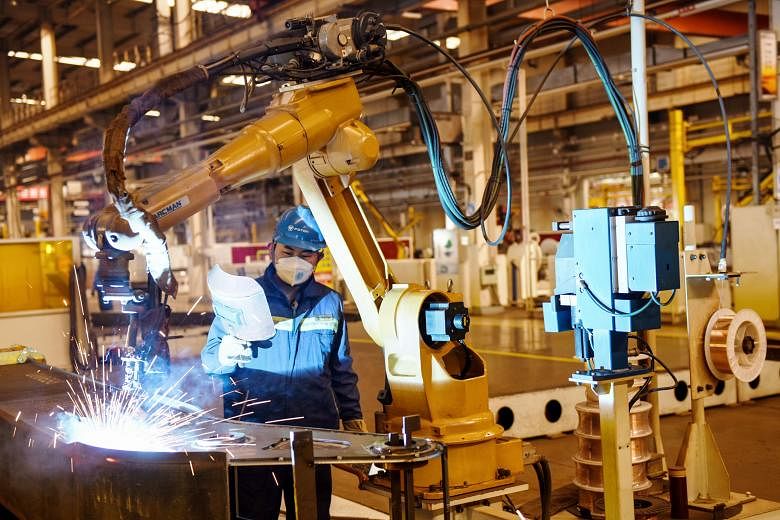BEIJING (BLOOMBERG) - Data on China's industrial output, investment and retail sales due on Monday (March 16) are forecast to show an across-the-board contraction for the first time on record, evidence of the extent to which the coronavirus has ravaged the economy.
The data is released on a combined basis to account for the normal seasonal swings around the Chinese New Year holiday.
The epidemic and attempts to slow its spread suddenly paralysed China's economy during that break, forcing consumers to cut spending and stay home; factories to extend their production halt, and trapping millions of people far from where they work. That crippled activity across the economy, with car and home sales slumping, and trade and travel interrupted.
"Most likely Jan-Feb is the lowest point for this year and the growth momentum is clearly improving in March," but the current consensus of 4 per cent GDP growth in the first quarter will be under pressure after the data, Macquarie Group Ltd Chief China Economist Larry Hu said on Friday. "The bad news is the recovery has been slower than expected, while the good news is that it's still recovering."
The central bank acted on Friday to soften the blow and help the economy, providing banks more money to lend by cutting the amount of cash they must place in reserve at the People's Bank of China. That cut takes effect on Monday, just as markets see the data for the first two months of the year.
INDUSTRIAL CONTRACTION
Industrial output, a rough proxy for economic growth, is forecast to have shrunk 3 per cent from a year earlier in the first two months of the year, according to a Bloomberg survey. That's down from a 5.7 per cent expansion in 2019 and would be the first time it's contracted in data back to 1998.
Manufacturers and the rest of the economy were mostly working in the first three weeks of the year. But even in January, the sector wasn't looking especially healthy, with the official gauge that tracks sentiment among purchasing managers at industrial firms at 50 for the month, right on the dividing line between expansion and contraction.
That then dropped to 35.7 in February, showing the effects of the longer-than-usual new year holiday and the delayed return to work. China's economy was likely only running at 60 per cent-70 per cent of its normal level at the end of February, according to an estimate from Bloomberg Economics.
Activity data for December showed signs of the improvement before the disease took hold, but for the first two months of the year it may show the economy sliding into uncharted waters as the coronavirus outbreak hamstrung businesses.
INVESTMENT COLLAPSE
Fixed-asset investment outside rural households, a closely watched indicator of construction activity, likely dropped by 2 per cent in the January-February period, the survey showed, in sharp contrast to the 5.4 per cent rise in 2019.
Infrastructure investment may have been hit the hardest of any sector, given restrictions on construction and large shortages of migrant workers. That slowdown is despite local governments issuing 950 billion yuan (S$191.8 billion) worth of special bonds in the first two months of this year - the proceeds of which are earmarked for infrastructure spending.
"The contraction in FAI investment may be deeper than that in industrial production, as many firms may need to cut their capex to survive the epidemic," Nomura Holdings Inc economists wrote in a note in late February.
SHRINKING RETAIL
Retail sales growth was already weak, with the 8 per cent expansion in 2019 the slowest pace since 1999. It's forecast to have contracted 4 per cent through the end of February, as many people were confined to their homes, shops were shut, delivery systems struggled, and most consumers tried to avoid visiting public places for fear of infection.
Restaurants, hotels and shopping malls were among the first to feel the devastating impact. Car sales, a key component of retailing, fell 18.7 per cent in January and 79.1 per cent in February from a year earlier, according to an industry group. Robust online shopping may alleviate some of those negative impacts but it's unlikely to fully offset them.
STABLE UNEMPLOYMENT
The negative effects on businesses will likely flow through to their employees, and the unemployment rate is a key indicator to watch. If businesses starts to lay off workers and joblessness rises, the government is more likely to step up stimulus, which so far has been mostly targeted at those in Hubei, smaller companies, or firms directly affected by the virus.
China's jobless rate moved in a tight band all 2019 and was at 5.2 per cent in December.
Economists have repeatedly marked down their growth forecasts on the slow resumption of business. The median forecast for year-on-year growth in the first quarter is 4.0 per cent, the weakest in 30 years, and that for 2020 is 5.5 per cent, according to a February survey.
The expectation is that growth will rebound later this year once the epidemic is brought under control, but that now hinges just as much on how the virus progresses overseas in China's markets as it does on what happens domestically.











